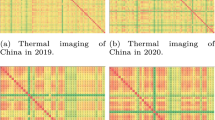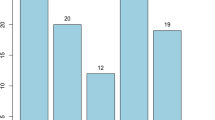Abstract
To study the characteristics of Chinese stock market, this paper analyses the undirected and directed stock market networks of the constituent stocks of CSI 300. We first apply the spectral clustering on the ratio of eigenvectors (SCORE) (Jin in Ann Stat 43(1):57–89, 2015) to detect the community structure of the undirected market network. Four communities are found and analysed in detail: “Financial industry (Securities category) community”, “Real estate industry community”, “Financial industry (Bank category) community” and “Heavy industry and Manufacturing industry community”. We then test the stability of the undirected stock network by analysing its topological stability, showing that the network is stable to random attacks but vulnerable to the particular type of deliberate attacks. We establish a directed market network to further analyse the characteristics of the Chinese stock market, exploring the characteristics of stocks with high in-degrees and out-degrees. During the network analysis, we describe the characteristics of the Chinese stock market from the perspective of network analysis, analysing the key companies and providing suggestions for the researchers and investors. Stock market network analysis also provides an effective practice and expansion of the statistical clustering algorithm. Our findings shed light on trends and topological patterns of stock market networks.






Similar content being viewed by others
Notes
Shandong Nanshan Aluminium
References
Albert, R., Jeong, H., & Barabási, A. (2000). Error and attack tolerance of complex networks. Nature, 406(6794), 378–382.
Bandyopadhyay, A., & Kar, S. (2018). Coevolution of cooperation and network structure in social dilemmas in evolutionary dynamic complex network. Applied Mathematics and Computation, 320, 710–730.
Bandyopadhyay, A., & Kar, S. (2018). Impact of network structure on synchronization of Hindmarsh–Rose neurons coupled in structured network. Applied Mathematics and Computation, 333, 194–212.
Bank of China Association. (2019). 2019 China Banking Top 100 List. http://www.chinabankingnews.com/2019/02/27/china-banking-association-releases-list-of-top-100-lenders/. Accessed 23 August (2020).
Baumöhl, E., Kočenda, E., Lyócsa, Š, & Vỳrost, T. (2018). Networks of volatility spillovers among stock markets. Physica A: Statistical Mechanics and its Applications, 490, 1555–1574.
Cohen, R., Erez, K., Ben-Avraham, D., & Havlin, S. (2000). Resilience of the internet to random breakdowns. Physical Review Letters, 85(21), 4626.
Danon, L., Diaz-Guilera, A., Duch, J., & Arenas, A. (2005). Comparing community structure identification. Journal of Statistical Mechanics: Theory and Experiment, 2005(9), 09008.
Fan, Q., & Wang, F. (2020). Detrending-moving-average-based bivariate regression estimator. Physical Review E, 102(1), 012218.
Fortunato, S. (2009). Community detection in graphs. Physics Reports, 486(3), 75–174.
Gao, C., Ma, Z., Zhang, A. Y., Zhou, H. H., et al. (2018). Community detection in degree-corrected block models. Annals of Statistics, 46(5), 2153–2185.
Girvan, M., & Newman, M. E. J. (2002). Community structure in social and biological networks. Proceedings of the National Academy of Sciences of the United States of America, 99(12), 7821–7826.
Han, D., et al. (2019). Network analysis of the Chinese stock market during the turbulence of 2015–2016 using log-returns, volumes and mutual information. Physica A: Statistical Mechanics and its Applications, 523, 1091–1109.
Huang, W., Zhuang, X., & Yao, S. (2009). A network analysis of the Chinese stock market. Physica A: Statistical Mechanics and its Applications, 388(14), 2956–2964.
Ji, P., & Jin, J. (2016). Coauthorship and citation networks for statisticians. Annals of Applied Statistics, 10(4), 1779–1812.
Jin, J. (2015). Fast community detection by score. Annals of Statistics, 43(1), 57–89.
Kang, S. H., & Lee, J. W. (2019). The network connectedness of volatility spillovers across global futures markets. Physica A: Statistical Mechanics and its Applications, 526, 120756.
Kullmann, L., Kertész, J., & Kaski, K. (2002). Time-dependent cross-correlations between different stock returns: A directed network of influence. Physical Review E, 66(2), 026125.
Kumar, S., & Deo, N. (2012). Correlation and network analysis of global financial indices. Physical Review E, 86(2), 026101.
Liu, X., Pan, L., Stanley, H. E., & Gao, J. (2019). Multiple phase transitions in networks of directed networks. Physical Review E, 99(1), 012312.
Ma, J., Yang, J., Zhang, X., & Huang, Y. (2015). Analysis of Chinese stock market from a complex network perspective: Better to invest in the central. In 2015 34th Chinese control conference (CCC), IEEE, pp. 8606–8611.
Majapa, M., & Gossel, S. J. (2016). Topology of the South African stock market network across the 2008 financial crisis. Physica A: Statistical Mechanics and its Applications, 445, 35–47.
Newman, M. E. (2001). Scientific collaboration networks, I: Network construction and fundamental results. Physical Review E, 64(1), 016131.
Qin, S., Chen, X., & Sun, W. (2011). Optimal investment portfolio model with degree risk in complex stock network. In 2011 Fourth international workshop on chaos-fractals theories and applications, IEEE, pp. 161–165.
Radicchi, F. (2015). Predicting percolation thresholds in networks. Physical Review E, 91(1), 010801.
Tabak, B. M., Serra, T. R., & Cajueiro, D. O. (2010). Topological properties of stock market networks: The case of Brazil. Physica A: Statistical Mechanics and its Applications, 389(16), 3240–3249.
Volpp, L. (2006). Complex networks: Structure and dynamics. Physics Reports, 424(4), 175–308.
Xixi, L., Qiang, W., & Suling, J. (2017). Analysis of topological properties of complex network of Chinese stock based on copula tail correlation. In 2017 International conference on service systems and service management, IEEE, pp. 1–6.
Yang, T., Chi, Y., Zhu, S., Gong, Y., & Jin, R. (2010). Directed network community detection: A popularity and productivity link model. In Proceedings of the 2010 SIAM international conference on data mining, pp. 742–753.
Yao, H., & Memon, B. A. (2019). Network topology of FTSE 100 index companies: From the perspective of BREXIT. Physica A: Statistical Mechanics and its Applications, 523, 1248–1262.
You, T., Fiedor, P., & Hołda, A. (2015). Network analysis of the shanghai stock exchange based on partial mutual information. Journal of Risk and Financial Management, 8(2), 266–284.
Zhang, J., & Chen, Y. (2017). A hypothesis testing framework for modularity based network community detection. Statistica Sinica, 27(1), 437–456.
Acknowledgements
This work was supported by the National Natural Science Foundation of China (Grant No. 12001557); the Youth Talent Development Support Program (QYP202104), the Emerging Interdisciplinary Project, the Disciplinary Funding, and the School of Statistics and Mathematics in Central University of Finance and Economics.
Author information
Authors and Affiliations
Contributions
Conceptualization and methodology: YY; formal analysis and investigation: BL and YY; writing—original draft preparation: BL and YY; funding acquisition: YY; resources: YY; supervision: YY.
Corresponding author
Ethics declarations
Conflict of interests
The authors declare no potential conflict of interests.
Human and Animal Rights
The authors declare no research involving human participants and/or animals.
Informed Consent
The authors declare informed consent.
Additional information
Publisher's Note
Springer Nature remains neutral with regard to jurisdictional claims in published maps and institutional affiliations.
Appendix
Appendix
1.1 Additional Results
Tables 6 and 7 show the top 20 stocks of the betweenness centrality and eigenvector centrality respectively. Tables 8, 9, 10 and 11 show all the stocks in each community.
Rights and permissions
About this article
Cite this article
Li, B., Yang, Y. Undirected and Directed Network Analysis of the Chinese Stock Market. Comput Econ 60, 1155–1173 (2022). https://doi.org/10.1007/s10614-021-10183-w
Accepted:
Published:
Issue Date:
DOI: https://doi.org/10.1007/s10614-021-10183-w




